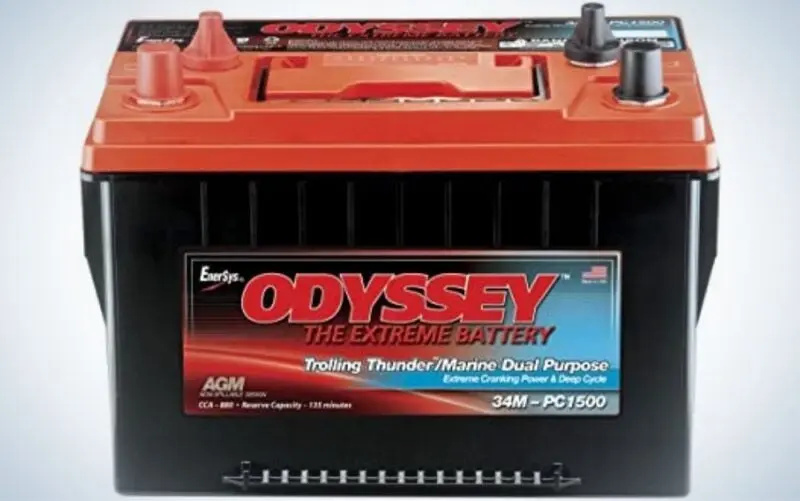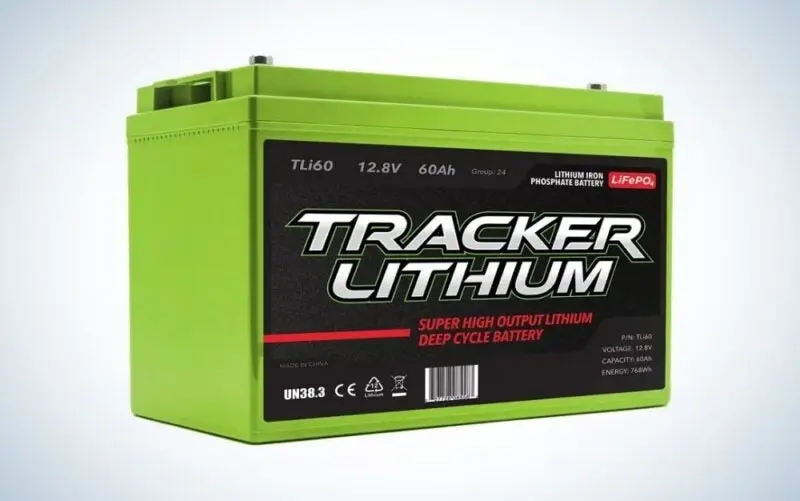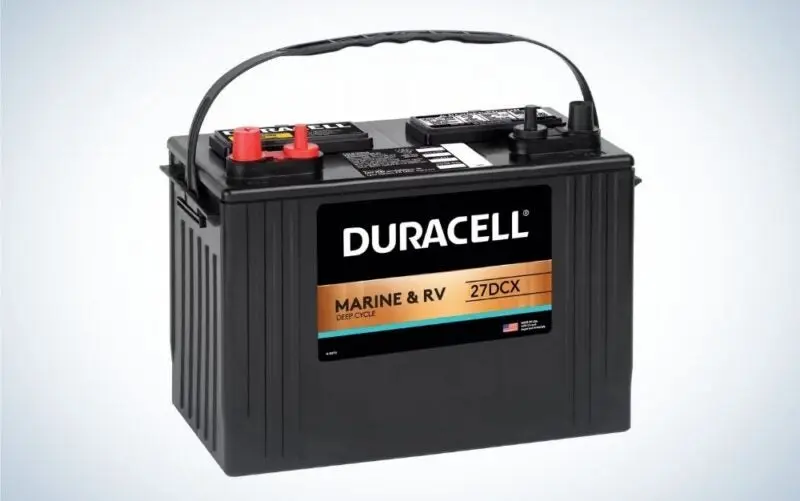_We may earn revenue from the products available on this page and participate in affiliate programs. Learn more ›
_
Best for Trolling Motor

Odyssey Extreme Trolling Thunder
Best Dual Purpose

Optima Blue Top
Best Lithium

Tracker Marine Lithium
Marine batteries are the unsung hero of the boating world. Just as boaters will go out of their way to find ethanol-free fuel and additives to keep their outboard running at peak performance, anglers will go to extreme lengths to keep the power flowing to their electronics and electric trolling motors
. For those of us who constantly look to upgrade our angling experience, a top-notch power bank is just as important as the modern tools it supports.
Like all products, the market is flooded with a variety of marine batteries. Some of these are better than others. I waded through the sea of batteries to find the ones worth having. Here are the best marine batteries to keep your fishing boat going so you can concentrate on what really counts: catching fish.
Best for Trolling Motor: Odyssey Extreme Trolling Thunder
Best Dual Purpose: Optima Blue Top
Best Lithium: Tracker Marine Lithium
Best for the Money: Duracell Marine
How We Picked The Best Marine Batteries
As a boat owner for the last 30 years, I’ve had the opportunity to fish on a weekly basis with a variety of flooded lead acid cells and sealed AGM batteries. In addition to my personal experience with lead acid batteries I have consulted many competitive bass anglers who have taken the plunge into lithium battery technology. These choices are based upon my research with these anglers as well as my personal experiences purchasing and fishing with these battery styles.
The Best Marine Batteries: Reviews & Recommendations
Best for Trolling Motor: Odyssey Extreme Trolling Thunder
Best for Trolling Motor

Specs
Group 31 AGM
92-amp hours
67 pounds
Pros
Rugged construction
Excellent lifespan
Good performance at lower charge levels
Cons
Expensive for a lead acid AGM battery
Heavy
Odyssey Marine AGM batteries are built specifically to handle the repeated discharges of anglers who spend many days per week on the water. While not as highly touted by professional anglers as lithium batteries, these stowaways are found in the power banks of many fishing guides who charge and deplete their batteries on a near daily basis. The batteries are a bit heavier than other AGM marine batteries, but that weight comes from the commercial heavy-duty construction that helps these power packs fend off some of the beatings that running at full speed in rough water can dish out.
Larger than normal cell sizes and pure lead plates offer more capacity as well, meaning you can spend more time on the water before you begin to notice any battery fade in the trolling motor prop or see voltage drop. These batteries are some of the most expensive AGM’s on the market, but most anglers we talked to have praised the price as money well spent.
For even more choices, check out our roundup of top trolling motor batteries
.
Best Dual Purpose: Optima Blue Top
Best Dual Purpose

Specs
Group 31 AGM
75-amp hours
61 pounds
Pros
900 cold cranking amps
Extremely resistant to vibration and rough treatment
Long lifespan
Cons
A bit light on the listed capacity
Although it’s listed as a group 31 battery, the Optima Blue Top actually has the same dimensions as most 27 group batteries, making it an easy upgrade for anglers looking for a little more juice without rearranging their boat’s battery compartment. Optima also seems to be a bit more conservative than other battery manufacturers when it comes to listing their batteries’ capacities. Although they list the 31M at 75-amp hours, in-the-field performance of these batteries far exceeded many competitors’ models that list at 80-amp hours and above. The AGM design of Optima batteries includes separate coiled cells with fiberglas mats, making them 100 percent spill proof, even if you mount them on an angle or on their side.
This dual-purpose battery also pumps out an astonishing 900 cold cranking amps, which will offer ripcord-like performance on the starter on pretty much any size outboard an angler is likely to have his or her boat. While it’s always best to have separate batteries for the trolling motor and outboard, this battery could easily pull double-duty for anglers should their primary starting battery decide to die at a bad time. While Optima may have been seen as expensive two decades ago, their continued track record and extended lifespan has proven itself to be well worth the extra money over flooded cell batteries. And, it’s a mid-priced battery in today’s market.
Best Lithium: Tracker Marine Lithium
Best Lithium

Specs
Group 27 Lithium Iron Phosphate
80-amp hours
23 pounds
Pros
Fast recharge time
Low weight
Extremely long lifespan
Cons
Not good for dual purpose use
Lifespan may not be worth high cost
While lithium marine batteries are still in their infancy, the Bass Pro Shops Tracker Marine brand has definitely embraced the technology, offering a variety of lithium batteries produced by RelION technology. While other brands have also contracted with the company, Bass Pro Shops seems to have the best current price for comparable models. In addition to a lifetime boasting more than 5,000 discharges, these batteries offer a decent capacity of 80-amp hours. However, anglers may be pleasantly surprised that they will see a longer period of high-power output, as these batteries perform much differently than lead acid cells.
While lead acid will slowly lose efficiency as they are discharged, lithium batteries provide close to the same discharge rate until they are nearly gone, giving the user more time at peak power. And instead of needing a full night to recharge after being depleted, this battery will power back up in as little as an hour and a half after a full discharge. The real question to ask is whether you honestly fish enough to keep up with this battery’s potential. After all, 5,000 discharges are equivalent to fishing every day of the year for more than 13 years! A weekend warrior may never see the savings.
Best for the Money: Duracell Marine DC27M
Best for the Money

Specs
Group 27 Flooded Cell
90-amp hours
53 pounds
Pros
Inexpensive
Solid performance with proper maintenance
Holds up to deep discharges as well as higher-priced brands
Cons
Limited lifespan
Maintenance and monitoring required
Call me a consumer, but I have just become accustomed to replacing my batteries once every three or four years. Even when I used AGM batteries, there was always a desire to upgrade or replace my old cells when they hit the four-year mark. As an average angler, I realistically average about 10 fishing trips per month, with spring and summer seeing many more trips than colder months. With that in mind, I’ve settled on the fact that I personally get the most bang for my buck out of Duracell deep cycle marine batteries. These batteries are made by Johnson Controls, the same manufacturer that produces most brands, including Walmart’s Everstart brand as well as AutoZone battery brands.
The 90-amp hour-rating of the 27 group deep-cycle marine battery gives plenty of power to keep a freshwater or saltwater trolling motor
turning, and I’ve never gotten less than three years out of each battery. The battery does require monitoring, as the water in the battery’s acid solution will evaporate some if the battery overheats during charging. But, checking the water level is as simple as popping the top off each cell and visually inspecting it to make sure the lead plates are submerged in liquid. At less than $100 per battery, you can purchase three of these batteries before you reach the price of a comparable AGM, and twice that before you approach the price of a Lithium battery.
What to Consider When Choosing a Marine Battery
Electrical engineers may have designed today’s top-quality batteries, but you don’t have to have a degree to narrow down your choices. Here are some of the aspects of marine batteries buyers need to pay attention to before pulling out the billfold and making a costly mistake.
Construction
For decades manufacturers were content with the standard flooded cell battery. Sealed batteries offered an improvement over the originals, but it wasn’t until recent forays into electric vehicle design that battery manufacturers were given the incentive to develop batteries that were lighter, held a charge faster and lasted for thousands of discharges.
Flooded Lead Acid: The basic battery your father probably used in his car, boat, and everything in between, flooded lead acid batteries have lead plates suspended in sulfuric acid that store and discharge electricity. Their simple construction makes them the least expensive option for marine batteries, and they tend to hold up for two to three years before needing to be replaced. Owners of these batteries should periodically check the level of the acid in the battery, as it can evaporate out during charging, leaving the lead plates dry. This damages the battery, making it less efficient, and eventually worthless.
Absorbed Glass Mat (AGM): One step above the flooded cells, AGM batteries still use acid and lead to react and store electricity. But the acid contained in these cells is soaked into fiberglas mats to prevent it from sloshing around or evaporating when the battery is being recharged. These batteries tend to last slightly longer than flooded cells, but their main advantage is that they require no maintenance.
Lithium Iron Phosphate: The latest technology for the modern boat, Lithium iron phosphate batteries have many advantages over flooded lead acid and AGM batteries, such as faster recharge times, less weight, and much longer lifespans. Those big-time benefits, however, come with a big-time price tag, sometimes costing as much as four or five comparably sized standard batteries. But even with the higher price, many consider these to be the best marine batteries.
Size
Marine batteries, with the exception of some specialty batteries to power motors designed for kayaks and canoes, fall into one of three sizes, labeled groups. Pay attention to how much room you have in your boat’s storage area and make sure you don’t purchase a battery that ultimately won’t fit the layout of your cargo hold.
Group Size 24: Typically reserved for starting batteries that won’t be required to handle larger battery drains. However, this battery group’s lighter weight and small dimensions makes it a favorite for small jonboats where space is at a premium.
Group Size 27: The standard battery size for most bass boats for both the deep-cycle trolling motor batteries and dual-purpose starting batteries that also run basic boat electronics, bilge pumps and lights.
Group Size 31: The larger dimensions of this battery group can mean more power capacity, but that capacity comes at the cost of weight and space. Many mid-sized boats may not have enough space to accommodate these large power cells.
If you have a kayak that you are looking to convert to power, check out our roundup of the best kayak motors
. We also have a bunch of useful tips for do-it-yourself outboard repairs
to keep your vessel ship-shape. Discover Boating also offers some helpful suggestions on boat maintenance
to keep your time on the water trouble-free.
Purpose
Batteries have three main uses on a boat: starting the outboard engine, fueling the electric trolling motor or powering all of the bilge pumps, aerators, lights and electronics found onboard. As fish finders have become larger and more advanced, they require much more power than previous flashers and basic graphs. Different uses call for different battery builds to get the most of each power cell stowing away in your boat.
Starting Battery: Starting batteries are designed with many thin lead plates to maximize the surface area of the chemical reaction taking place to release stored electricity. The thin plates offer sudden bursts of high energy, but do not hold up well to being drained too deeply then recharged.
Deep-Cycle Battery: The opposite end of the battery spectrum from starting batteries, deep-cycle batteries have fewer, but thicker plates suspended in the acid solution. This offers a lower output of current, which allows the battery’s energy reserve to last much longer. The thicker plates also resist damage caused by use, letting the user drain the battery’s power much further when operating electric devices such as trolling motors.
Dual-Purpose Battery: Mister middle-of-the-road, the dual-purpose battery offers enough instant power to crank most outboards, but also has large enough plates to handle regular discharges from electronics and aerators that may run all day.
If you need a portable battery pack to keep your cell phones or other electronics going, check out our roundup of the best power banks
.
Capacity
For most boating purposes, capacity can be measured in one of two readings, depending upon the purpose of the battery.
For starting batteries, it’s all about instantaneous output, which is measured as Cold Cranking Amps (CCA). As long as the starting battery meets the CCA requirement of your outboard, it will perform as needed until it needs to be replaced. There’s really no need to spend extra money on higher CCA batteries than what your outboard needs.
For dual-purpose and deep-cycle batteries, a battery’s amp hours can offer a good indication of its reserve. While amp hours are actually a measure of how much charge goes into the battery during charging, it offers a relative number to compare batteries of different sizes and types. For most trolling motors, batteries of 80- to 100-amp hours will provide a full eight-hour day of use under normal conditions. Fighting high winds and current can deplete batteries quicker, cutting that usage considerably.
FAQs
Q: Do I really need a marine battery for my boat?
Marine batteries are designed to withstand the wet environments found in boat cargo areas as well as the abuse pounding waves can deal out on a voyage. A boater might be able to get by with a battery intended for a car or other vehicle type, but that power source may suffer catastrophic failure from the extreme environments where anglers depend on their equipment. Lower output rates can mean higher amperage draws as well, which can cause damage to some marine electronics if used on a regular basis. Anglers using a standard car battery to power a trolling motor also may find themselves wanting more capacity, as starting batteries are designed to deliver large amounts of current in short bursts, while trolling motors require lower amounts of energy spread out over a long period of time.
Q: Can you overcharge a deep-cycle battery?
Most modern battery chargers have safeties built in to shut off when a battery is fully charged, but it is still possible to overcharge a deep-cycle battery. When the battery overheats, the water in the sulfuric acid solution within its case will boil and escape, leaving dry lead plates behind, which sulfate and lose their capacity. If the overcharging continues or the water isn’t replaced, the battery can be a complete loss. Overcharging often is the result of the user not choosing the correct setting on their battery charger. While rare, a charger or battery maintainer’s failsafe can malfunction, so it’s always best to keep an eye on your charging status and not rely too heavily on the charger handling it for you.
Q: Which is better, AGM or lithium battery?
If money were no object, lithium batteries would be the obvious choice over lead acid batteries. The lithium battery provides more power with less weight, a longer lifespan and a much more constant power output before it becomes weak. However, all those benefits come at a higher cost. While lithium battery costs are slowly decreasing, they are still a bit more expensive than most of the AGM batteries on the market.
Best Marine Batteries: Final Thoughts
Best for Trolling Motor: Odyssey Extreme Trolling Thunder
Best Dual Purpose: Optima Blue Top
Best Lithium: Tracker Marine Lithium
Best for the Money: Duracell Marine
The value you experience in a marine battery ultimately depends upon the user and how often the battery is used. A lithium battery may allow up to 10 times the number of discharges as comparable flooded cell or AGM batteries, but if the buyer doesn’t use their boat and batteries on a weekly basis, they may never use the batteries long enough to offset the additional expense. Likewise, if a boater isn’t willing to put in the extra monitoring and maintenance standard flooded cells require, they may damage the less expensive option, requiring regular replacements.
Why Trust Us
For more than 125 years, Field & Stream has been providing readers with honest and authentic coverage of outdoor gear. Our writers and editors eat, sleep, and breathe the outdoors, and that passion comes through in our product reviews. You can count on F&S to keep you up to date on the best new gear. And when we write about a product—whether it’s a bass lure or a backpack—we cover the good and the bad, so you know exactly what to expect before you decide to make a purchase.
![Field & Stream [dev]](https://images.ctfassets.net/fbkgl98xrr9f/1GnddAVcyeew2hQvUmrFpw/e4ca91baa53a1ecd66f76b1ef472932b/mob-logo.svg)




